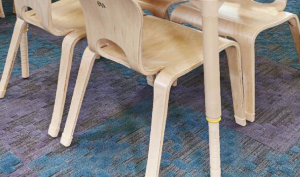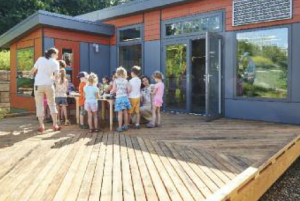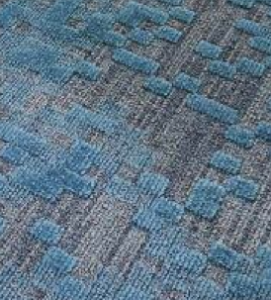Spring 2016
Mohawk carpet tile in Pittsburgh SEEDclassroom meets Living Building Challenge standards
 American schoolchildren attend classes in more than 350,000 portable classrooms. In the next two years, 100,000 to 150,000 additional portables are projected for the academic landscape. Standard portable classrooms provide a quick solution for expansion, but they are typically not the optimum healthy living environments for students.
American schoolchildren attend classes in more than 350,000 portable classrooms. In the next two years, 100,000 to 150,000 additional portables are projected for the academic landscape. Standard portable classrooms provide a quick solution for expansion, but they are typically not the optimum healthy living environments for students.
Sustainable Education Every Day (SEED) promotes this initiative of healthy learning environments. SEEDclassrooms are modular, hands-on, sustainable learn- ing spaces built to Living Building Challenge standards. They are brightly day lit, well-ventilated places that have exposed systems — with accompanying lesson plans — to make them the ultimate teaching tools. They are also net zero energy and net zero water. SEEDclassrooms provide a healthy and sustainable alternative to standard modular classrooms, which typically have poor daylighting and inadequate access to natural ventilation, and are constructed of materials that can have high levels of toxins.
In addition to the two SEEDclassrooms that have been built in Seattle and another under construction at a charter school in Washington, D.C., one was recently completed at the Phipps Conservatory and Botanical Gardens in Pittsburgh. Products manufactured by Mohawk Group, which has dedicated the last decade to leading the building product manufacturing sector in sustainability with a unique focus on transparency, were used in the Phipps classroom.
 “The carpet tile used in the Phipps SEEDclassroom — Lees Sequences II Collection — is one of more than 490 Mohawk products that are Red List free,” said Rochelle Routman, Mohawk’s vice president of sustainability. “In addition, Sequences II carpet tile has EcoFlex NXT, which is a PVC-free backing that is lighter than similar PVC products, making it easier to install and reducing the carbon foot- print in shipping.”
“The carpet tile used in the Phipps SEEDclassroom — Lees Sequences II Collection — is one of more than 490 Mohawk products that are Red List free,” said Rochelle Routman, Mohawk’s vice president of sustainability. “In addition, Sequences II carpet tile has EcoFlex NXT, which is a PVC-free backing that is lighter than similar PVC products, making it easier to install and reducing the carbon foot- print in shipping.”
The Phipps SEEDclassroom features various nontoxic materials, generates its own energy and recycles water on site.
The building shows what healthy spaces look like for kids and calls attention to the importance of providing healthy learning environments for young students.
Stacy Smedley, co-founder of the SEEDcollaborative and preconstruction manager and sustainable initiative lead for Skanska USA Building, said she hopes to make Mohawk a national partner in SEEDclassrooms as the company’s carpet tile offerings are well designed and meet Living Building Challenge standards. The Living Building Challenge is a rigorous building certification program that calls for the creation of building projects that operate as cleanly, beautifully and efficiently as nature’s architecture.
 “With Mohawk we were able to design a custom carpet floor that we know is healthy for kids,” Smedley said. Children even helped design this special floor in the Phipps classroom. They wanted it to look like water, so SEED gathered student input to create the appearance of water from above, similar to what would be seen out of an airplane window. “We used the colors of water and other textures of blue [in the Pix II design from the Sequences II Collection] to create a beautiful landscape on the floor rather than just a typical carpet.”
“With Mohawk we were able to design a custom carpet floor that we know is healthy for kids,” Smedley said. Children even helped design this special floor in the Phipps classroom. They wanted it to look like water, so SEED gathered student input to create the appearance of water from above, similar to what would be seen out of an airplane window. “We used the colors of water and other textures of blue [in the Pix II design from the Sequences II Collection] to create a beautiful landscape on the floor rather than just a typical carpet.”
The new home of Phipps’s science education program is expected to impact thou- sands of children each year as they visit the SEEDclassroom. There they will find a classroom that brings nature indoors and inspires a new generation to consider the possibilities if every building was living.
A SEEDclassroom has the same spatial footprint as a standard portable class- room at 896 square feet and houses about 30 students; that is where the similarities end. Smedley said while a SEEDclassroom costs about $100,000 more to build than a standard portable classroom, it more than pays for itself in future savings and has the added components of healthy materials, daylighting via added operable windows and solatube skylights, water collection and reuse, a bathroom and enough solar panels to generate all of its energy. SEEDclassrooms have no utility bills and are built to last 50 years (as opposed to the typical estimated 20-year lifespan of standard portables).